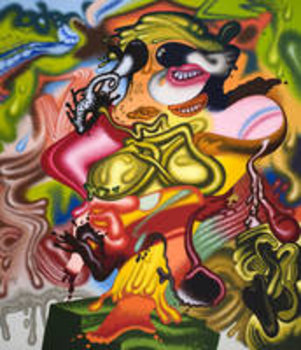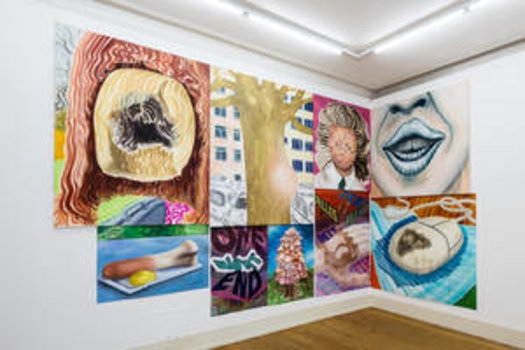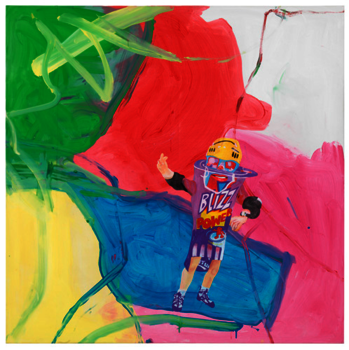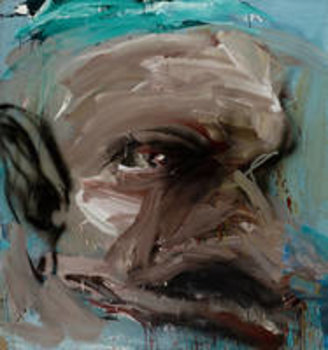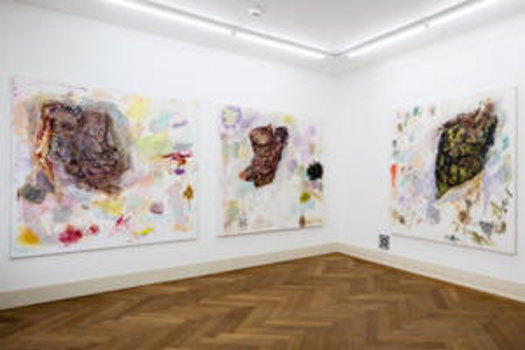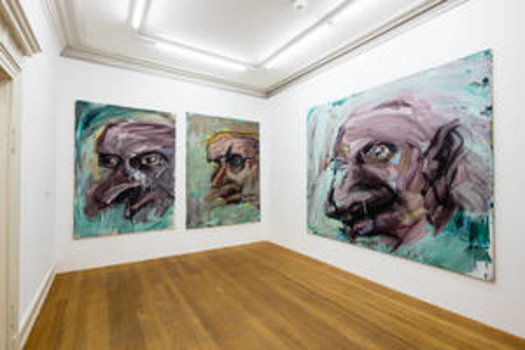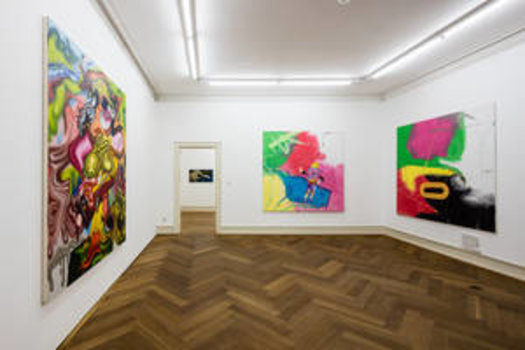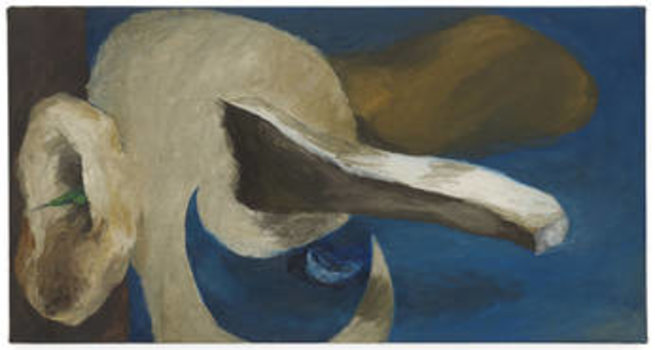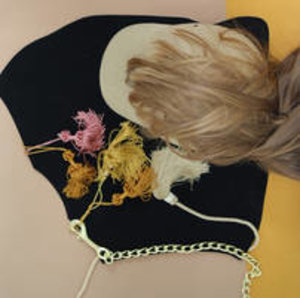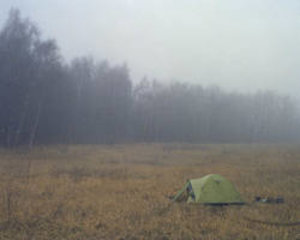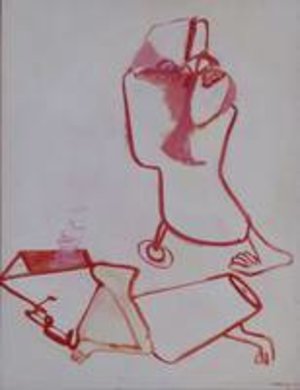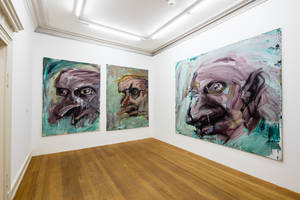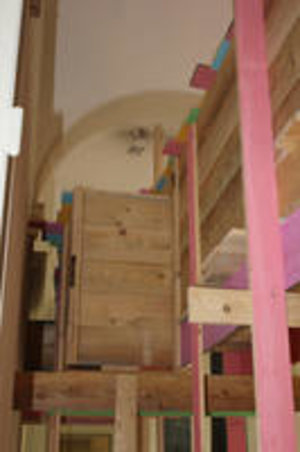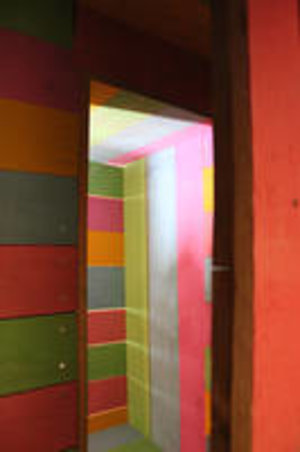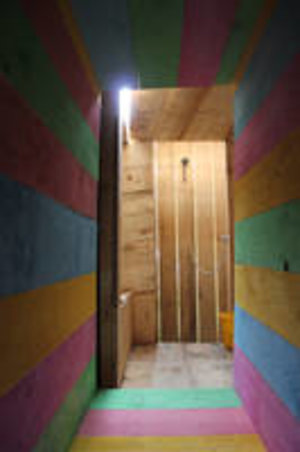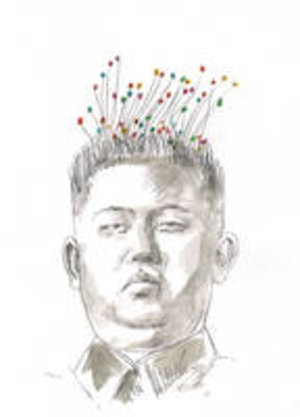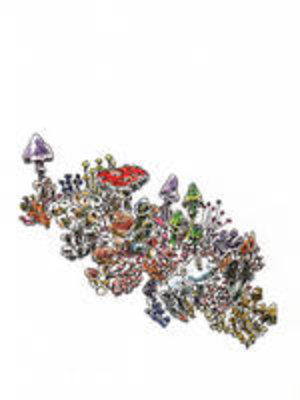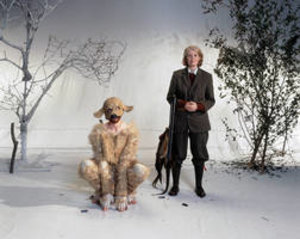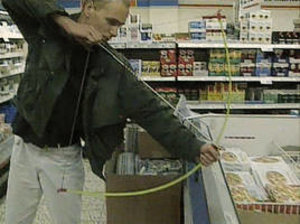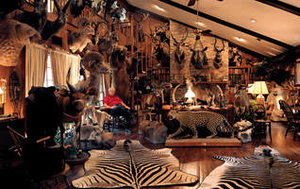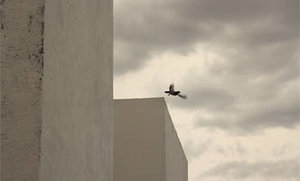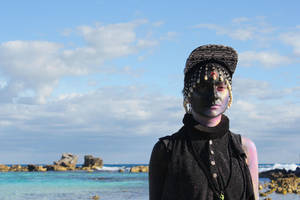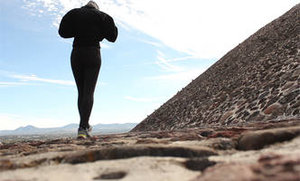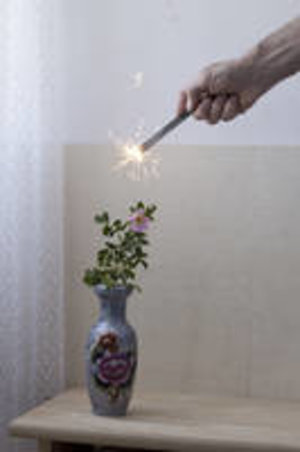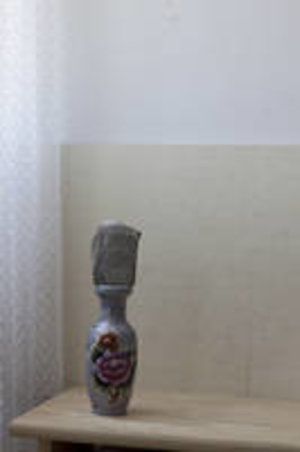Installationsansicht, Better than de Kooning
2015, von links nach rechts: Peter Saul, Better than de Kooning, 2008, Courtesy David Nolan Gallery, New York; Michel Majerus, Commercial Face of Contemporary Art 1, 1997, Courtesy Privatsammlung, Berlin; Michel Majerus, Commercial Face of Contemporary Art 4, 1997, Courtesy neugerriemschneider BerlinFoto: die arge lola28 November 2015 – 17 January 2016
Bahnwärterhaus:
Under Construction
Opening: Friday, 27 November, 7:00 pm
Valentino Biagio Berndt, Elsa Farbos, JAK, Alberto Zamora Ruiz
‘Under Construction’ is a two-part exhibition series which uses the Bahnwärterhaus as a platform for young, international artists. The title ‘Under Construction’ stands for a process that has not come to a conclusion. The works are open constructions which which are capable of being continued. The selected artists are linked by the fact that the current focus of their lives is on the Stuttgart region. The place where they live or study at the moment, however, is only part of the overall construction. The works open up connections to other, sometimes virtual locations and direct attention into the future or back into the past. Highly individual and extremely diverse developments come to the fore. Four positions set the stage in the first part of the series. A road vehicle developed by Valentino Biagio Berndt (*1988, Cuernavaca, Mexico) seems like the prototype for a new type of trend sport. It moves with apparent effortlessness between real and digital spaces. The paintings of Alberto Zamora Ruiz (*1982, Mexico City) likewise usher the viewer into the digital world. Various scenarios consisting of material from the Internet are brought together into a new, open narrative. Like the sketches for a storyboard, the pictures are placed in a more extensive context and cohere into several, constantly new stories. For its part, their integration into a wall-painting could be an indication that not only are the scenes virtual phenomena, but they also indisputably have real backgrounds.
On the other hand, the differentiation between reality and virtuality is utterly denied by JAK. It is impossible to precisely situate JAK among the genres of screenplay, film, installation and sculpture. All contents focus on JAK and everything was produced by JAK. This is not the matter of an artistic personality in the traditional sense. A feature-film project set up over several years is currently acquiring more and more form and serves as the basis for the installation that is on display here.
Finally, the installations of Elsa Farbos (*1987, Sant German en Laye, France) are based on the non-real. Among other things, the artist uses wood and plaster to shape delicate, fantastical beings which seem like the first designs for a new species. The volume of the tiny plaster animals consists of piled-up, powder-like hills. Nothing is irrevocably defined. The question remains open as to whether the construction phase is leading to concrete outcomes, or whether everything remains a stimulating illusion.
The second part of ‘Under Construction’ will follow with further positions from 23 January to 28 February 2016 in the Bahnwärterhaus.
Curator: Anka Wenzel
12. September 2015 – 15. November 2015
Jeanne Faust – 7 dealers
Opening: Friday, 11 September, 7pm
In her videos and photographs, Jeanne Faust plays with various perceptual levels of the viewer. The fundamentally narrational approach of her cineastic pictorial spaces initially gives rise to a supposedly familiar narrative structure which, however, is continuously disrupted. The fragments of image, text and action in her works are based on storyboards that she constructs herself and on carefully planned scenes that she realizes under her own direction.
Through the interplay between verbal, visual, literary and cineastic allusions, there is an interpenetration of concrete and imagined pictures that confront the viewer with a strangely familiar, but equally strange atmosphere. Jeanne Faust – 7 Dealers presents at the Villa Merkel in Esslingen three video installations along with photographs, a storyboard and further, extremely poetical works.
12 September – 15 November 2015
Better than de Kooning
Opening: 11. September, 7:00 p.m.
With works by Peter Saul, Lee Lozano, Maria Lassnig, Michel Majerus, Dieter Krieg, Tim Berresheim, Jana Euler, Katrin Plavčak, Jon Rafman, Gunter Reski, Matthias Schaufler, Jim Shaw, Amy Sillman, Sue Williams
The Villa Merkel, Galerien der Stadt Esslingen am Neckar, is presenting in the autumn of 2015 an extensive painting exhibition that directs its focus toward the depiction of distortions in the human image in postmodernism. The process of the de- and reconstruction of the naturalistic image of the human being was one of the major driving forces in the development of painting in the twentieth century and, in the framework of the digital era, is picking up speed once again. The title of the exhibition, Better than de Kooning, refers to the same-named work created in 2008 by the American artist Peter Saul who, with his concept of painting-appropriation, which is nourished both by Surrealism and Abstract Expressionism as well as by underground comics and political caricature, developed an innovative politpop painting style. The exhibition presents works by fourteen artists of European and American provenance over several generations who operate in terms of both form and contents between a conceptual reception of painting and an investigation of influences from the mass media.
At the same time, the exhibition will establish a bridge to caricature, comics and the animated films of the nineteenth and early twentieth centuries, and thereby illuminate the beginnings and interconnections of this thematic area.
Bringing together more than fifty paintings, the exhibition Better than de Kooning will extend over the entire upper floor of the Villa Merkel and retrace the interaction between painterly deformations of the human figure and mass-media images from 1961 to the present. The works on display will thereby enter into correspondence with an extensive wall collage consisting of caricatures, panels from comics and film stills.
Curators: Marcus Weber and Andreas Baur
Exhibition concept: Marcus Weber
A catalogue (German/English) with texts by Esther Leslie, Marcus Weber and Andreas Baur, as well as an interview of Peter Saul by Marcus Weber, will be published by Snoek Verlagsgesellschaft mbH, Cologne.
27 June – 23 August 2015
Les Frères Chapuisat
Excrescence of Immortality
Interactive Construction Phase with Special Programs: from 21 May 2015
Exhibition Phase: 27 June ‒ 23 August 2015
Opening: Friday 26 June, 7:00 p.m.
From a biological point of view, mushrooms are neither plants nor animals. They constitute their own third category. From time immemorial, they have been organisms with a mysterious aura, yet their existence is an everyday and indispensable occurrence in a flourishing ecosystem.
Les Frères Chapuisat have made an approach to the essence of mushrooms. Under the title Excrescence of Immortality, which refers to the primal power of these special organisms, Les Frères Chapuisat are appropriating the Villa Merkel. An architectural structure will spread throughout the ground floor of the Villa Merkel and serve as a living space for artists and fungi.
In its construction, this structure resembles the architecture of a monastery or a temple. Divided into social, contemplative and informative units, actual spatial structures are combined with narrative elements. This generates an independent organism into which the visitor is incorporated. An integrated library, a cinema and spaces of encounter provide insights into the significance and potentialities of the construction.
The architectural constructions by Les Frères Chapuisat often involve space-encompassing and larger-than-life formations. The precise planning of apparently chaotic structures gives rise to works that operate along the border of technical feasibility.
The two brothers Gregory and Cyril from Geneva conceive of Les Frères Chapuisat as an open community. Their installations are realized with additional persons and in consideration of specific on-site conditions. In this sense, the time-consuming setting-up process is part of the life philosophy of Les Frères Chapuisat. In accordance with a nomadic principle, the artists live at the respective project sites and, if possible, inside the installations themselves. In an interactive construction phase, the ongoing process at the Villa Merkel will be opened to public view through regularly occurring programs.
Like an organic structure, this is an expanding principle that is open to external impulses. The process is accompanied by further artistic interventions.
Curator: Anka Wenzel
With the support of
![]()
27 June – 23 August 2015
Guest contributions on the upper floor
The exhibition “Excrescence of Immortality” functions like an organic structure that constantly grows further and is open to external impulses. The process is accordingly accompied by two additional, independent postions that take up the theme.
&nbs
Stephan Henrich“The Fungus Project — On Robotic Gardeners and vertical Scrubs”
The architect Stephan Henrich created a living compound material out of oyster-mushroom mycelia and straw. With the help of a robotic gardener that he developed himself the natural organism is erected in a wall-like structure. The Fungus Project investigates reciprocal relationships between architecture, nature, human beings and robotic machines that can be used for supporting architectural processes. The Fungus Project was realized in the framework of a research fellowship at Schloss Solitude 2010/2011.
Heiko Sievers — Mushroom of the day
Day after day, a Small-format mushroom picture has been painted by the Berlin artist Heiko Sievers. At almost the same time, the pictures become visible in his blog. They sprout ceaselessly and form adigital cosmos in which references to current events, political affairs and private matters find a place and immediately begin to rot. The exhibition presents a selection of original drawings from what has grown to be more than 1,000 motifs. While on one day many small mushrooms combine in solidarity into occupy mushroom, on another day mushrooms sprout from the heads of politicians (http://mushroom-of-the-day.blogspot.com).
http://mushroom-of-the-day.blogspot.de/
Curator: Anka Wenzel
14 March – 17 May 2015
Hunters & Gatherers
In Contemporary Art
Opening: Friday, 13 March 2015, 7 pm
David Chancellor, Henry Coombes, Sinje Dillenkofer, Mark Dion, Daniel & Geo Fuchs, Christian Gonzenbach, Roderick Hietbrink, Carsten Höller, Christian Jankowski, Claus Kienle, William Lamson, Isa Melsheimer, Guy Oberson, Simona Pries, Glen Rubsamen, Erik Schmidt, Andreas Slominski, TINKEBELL, Francis Zeischegg
The days when we used to range through the wilds of the old world as hunter-gatherers looking for something edible are long gone. But is that chapter in the history of mankind really closed? Aren’t the hunting instinct and a passion for collecting still motors driving human deeds? How much of the ‘hunter-gatherer’ remains within us is a question asked by contemporary artists such as Christian Jankowski, who, in his video performance The Hunt, slays his prey with a bow and arrow in the supermarket.
Hunting and gathering – as two elementary cultural techniques, as two ways of approaching and appropriating nature – are still closely intertwined. As he hoards slayed animals as trophies, the hunter becomes a collector, and as the collector searches
hunting lodge (The Glutton) by the American artist Mark Dion stands in stark contrast to the idyll of the surrounding parkland. And Francis Zeischegg’s elevated hunting blind, constructed especially for the ‘Hunters and Gatherers’ exhibition project, offers visitors an unusual perspective.
This is a cooperative project with the Morsbroich Museum in Leverkusen, where the exhibition is shown from 21 September 2014 until 11 January 2015.
A catalogue with texts (German) by Markus Heinzelmann, Andreas Baur, Fritz Emslander, and Gabriele John is published at Wienand Verlag, Cologne.
Curator: Fritz Emslander
Debut Exhibition in the Bahnwärterhaus
14 March – 19 April 2015
Yasmin Senkal
I AM DEATH
Opening: Friday, 13 March 2015, 7:00 pm
In 2015 the Galerien der Stadt Esslingen, together with the Stuttgart State Academy of Art and Design, is already realising for the third time two debut exhibitions in the Bahnwärterhaus.
The second debut exhibition in this year is being realised by Yasmin Senkal under the title ‘I AM DEATH’. In her performances, videos and installations, the artist plays with various subcultural aesthetics and links them with staged scenarios which have a spiritual underpinning. Using poems that she has written herself along with personal thoughts and musical interludes, the artist creates performances and video works with audio- and video-projections.
In her works, Yasmin Senkal creates her own worlds in which she herself, by means of self-stagings involving costumes, takes on a fundamental role. Concrete landscapes—for example, the ruins of the prehistorical city Teotihuacán located in the Mexican state of Mexico—are distorted in a surreal manner. In so doing, Yasmin Senkal makes use of established montage techniques from films, advertisements and music videos. This procedure gives rise to pictures which do not reveal a concrete, historical sequence of events but which nevertheless, through their narrative potential, exert a compelling fascination.
In allusion to Teotihuacán’s pyramid entrance, the portal to the Underworld, the Kingdom of the Dead, Yasmin Senkal has realised for her debut exhibition ‘I AM DEATH’ an entire cosmos of her own consisting of objects, collages, installations, documented performance and videos.
An artist’s book with collages and texts has been published on the occasion of the exhibition. It may be purchased at the Bahnwärterhaus (25 euros).
Yasmin Senkal (*1986 in Tübingen, lives in Berlin) studied free art at the Stuttgart State Academy of Art and Design with Prof. Werner Pokorny, Prof. Nicole Wermers and Prof. Mariella Mosler.
Debut Exhibition at the Bahnwärterhaus
24 January – 1 March 2015
Ülkü Süngün
Anlatsam Roman Olur — Life Writes The Best Novels
Volume 1 — Nothing But Rocks
Opening: Friday, 23 January 2015, 7:00 pm
In 2015 the Galerien der Stadt Esslingen, together with the Stuttgart State Academy of Art and Design, is already realising for the third time two debut exhibitions in the Bahnwärterhaus.
The first debut exhibition of this year is being realised by Ülkü Süngün. The artist, who grew up in Turkey and Germany, uses photography and installation in order to investigate issues revolving around the theme of asylum. The exhibition in the Bahnwärterhaus is especially concerned with the living conditions of refugees and asylum seekers in the European Union. Serving as one basis among others is the format of the photographic novel, which was a popular medium of entertainment up into the 1970s, primarily in Italy and Turkey. In developing the questions she raised concerning this theme, Ülkü Süngün focuses on an individual life story. Proceeding from an encounter with the ageing Georgian refugee Sergo Pipia and his sick wife Marina, she endeavours to convey the actual circumstances that define their life, to understand their longings and anxieties. At the time of her encounter with them, the couple had already withdrawn their application for asylum and were waiting to return home. Without being able to speak a common language, the three develop a photographic novel with the title ‘Nothing But Rocks’. In the exhibition, the photographic novel is presented as a space-encompassing staging situated between documentation and narrative fiction: Sergo Pipia first collects rocks from the Lauter River, which flows near his asylum-seekers’ housing in Kirchheim unter Teck, and uses them to create richly detailed reliefs with architectural and vegetable motifs. At the end, he is able to create an enchanting effect. With their imminent expulsion looming, the couple’s everyday life veers into absurdity. The importance which Ülkü Süngün attaches to personal encounter gives rise to questions, arouses feelings and leads to an intensive examination of her own position within this encounter. The artist brings this process to light.
Moreover, the rocks arranged by Sergo Pipia and his own manner of presentation serve as the basis for the installation ‘Lacrimarium Europae’ (‘Tear-Glass from Europe’) on the upper level of the Bahnwärterhaus. Ülkü Süngün takes the artistic motifs of Sergo Pipia seriously and responds to them as an impulse for speaking about survival strategies employed by refugees. Contradictory truths, feigned marriages or religious conversions bring to the fore a subversive strategy for survival with regard to the feared but so deeply longed-for Europe. Official documents and handwritten letters which describe in foreign languages the life stories of individual refugees are linked in the exhibition with narrative photographic sequences, personal objects and photographic realisations of personal dreams and visions which the artist combines out of her encounters with many refugees.
Ülkü Süngün discovers her own format for presenting issues involving the reality faced by refugees as well as governmental policies. The medium of the photographic novel is inherently involved with an emotional interest in the destinies of individual persons and makes it clear that the negotiation and contextualisation of political relationships is not only difficult, but accordingly all the more necessary.
Ülkü Süngün (*1970 Istanbul, lives in Stuttgart) studied sculpture and free art at the Stuttgart State Academy of Art and Design with Prof. Werner Pokorny, Prof. Udo Koch and Prof. Felix Ensslin.
The debut exhibition is being realised in collaboration with the Stuttgart State Academy of Art and Design.

